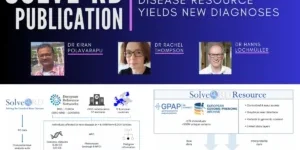New Publication: Development of a riboflavin-responsive model of riboflavin transporter deficiency in zebrafish
Riboflavin transporter deficiency (RTD) is a rare genetic disorder in children, characterised by progressive sensorimotor and cranial neuronopathy caused by mutations in riboflavin transporter protein-encoding genes. It often results in severe muscle weakness of arms and legs, deafness, blindness and permanent disability. The primary RTD treatment is high-dose riboflavin supplementation and although it effectively ameliorates symptoms in at least half of patients, it does not improve symptoms in the remaining patients. This treatment limitation may be due to the rapid excretion of riboflavin from the body at high plasma concentrations. The clinical variability in treatment response highlights the need for alternative or supplemental treatments for RTD that increase the retention of riboflavin in the body. So far, there was a lack of good animal models to test new treatments for this condition.
Our new collaborative study, “Development of a riboflavin-responsive model of riboflavin transporter deficiency in zebrafish” published recently in the journal Human Molecular Genetics, addresses the need for novel therapeutic strategies for RTD by developing a zebrafish model of riboflavin transporter deficiency for use in therapeutic screening of riboflavin and candidate therapeutics.
Lab member Catherine Choueiri is the first author, who carried out the experiments as part of her Masters project under the guidance of Dr. Alexander MacKenzie, Dr. Izabella Pena, and Dr. Hanns Lochmüller .
Catherine used antisense morpholino oligonucleotides to develop a knockdown model of SLC52A3 ortholog slc52a3. The slc52a3 knockdown model was then used for therapeutic screening of riboflavin and candidate drug probenecid, and identification of phenotypic improvements in response to treatment. In parallel, CRISPR/Cas9 technology was employed to initiate development of a stable genetic knockout of slc52a3. The slc52a3 knockdown phenotype is ameliorated following riboflavin treatment, which is reflective of clinical findings. However, riboflavin and probenecid co-treatment was not found to further improve the knockdown phenotype beyond a minor improvement in hearing.
This study presents the first viable in vivo vertebrate model of RTD generated via constitutive knockout of a RTD disease gene ortholog.
Our model can quickly test candidate drugs for their efficacy as an alternative RTD therapy so candidate drugs can easily be screened to move forward in the research pipeline, reducing downstream resources spent on unsuitable candidate drugs and increasing the likelihood of finding and re-purposing therapeutics to treat the symptoms of RTD in patients.
Reference:
Catherine M Choueiri, Jarred Lau, Emily O’Connor, Alicia DiBattista, Brittany Y Wong, Sally Spendiff, Rita Horvath, Izabella Pena, Alexander MacKenzie, Hanns Lochmüller, Development of a riboflavin-responsive model of riboflavin transporter deficiency in zebrafish, Human Molecular Genetics, 2024;, ddae171, https://doi.org/10.1093/hmg/ddae171.







